Related Research Articles

Sir George Biddell Airy was an English mathematician and astronomer, and the seventh Astronomer Royal from 1835 to 1881. His many achievements include work on planetary orbits, measuring the mean density of the Earth, a method of solution of two-dimensional problems in solid mechanics and, in his role as Astronomer Royal, establishing Greenwich as the location of the prime meridian.
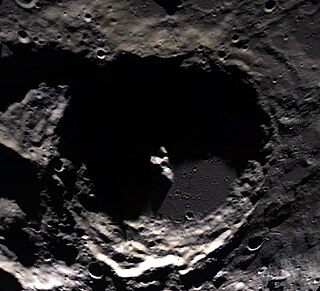
Amundsen is a large lunar impact crater located near the south pole of the Moon, named after the Norwegian explorer Roald Amundsen. It lies along the southern lunar limb, and so is viewed from the side by an observer on the Earth. To the northwest is the crater Scott, a formation of similar dimensions that is named for another Antarctic explorer. Nobile is attached to the western rim.

Aristoteles is a lunar impact crater that lies near the southern edge of the Mare Frigoris and to the east of the Montes Alpes mountain range. It was officially named in 1935 after the ancient Greek philosopher Aristotle by the International Astronomical Union, using the classical form of his name.

Dawes is a lunar impact crater located in the wide straight between Mare Serenitatis and Mare Tranquilitatis. To its southwest lies the larger crater Plinius, and to its northeast sits the Mons Argaeus mountain rise. It is named after British astronomer William Rutter Dawes.
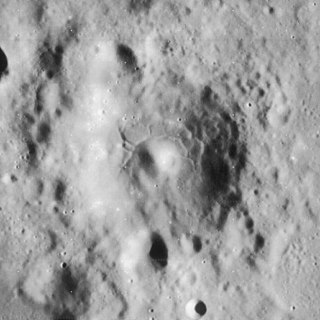
Airy is a lunar impact crater located in the southern highlands. It is named in honour of British astronomer George Biddell Airy. It forms the southernmost member of a chain of craters consisting of Vogel, Argelander, and Airy. A little further to the south lies Donati. Airy has a worn, and somewhat polygonal rim that it broken at the northern and southern ends. It has an irregular floor and a central peak.
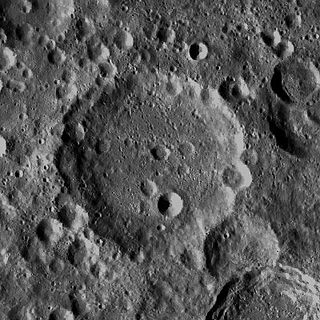
Anderson is a lunar impact crater that is located on the far side of the Moon. It is located to the northwest of the crater Sharonov, and the satellite crater Sharanov X is attached to the southeast rim of Anderson. To the northeast is the peculiar formation Buys-Ballot, and to the east-southeast lies the larger crater Spencer Jones.

Argelander is a lunar impact crater that is located in the south-central highlands of the Moon. It was named after the German astronomer Friedrich Argelander. It lies in the midpoint between the smaller crater Vogel in the north and the larger Airy to the south. To the northwest is the worn remnant of Parrot. Just to the west is a shallow cleft in the surface that follows a course to the north-northwest, intersecting the southeast rim of Parrot.
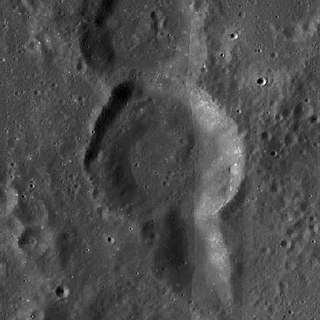
Vogel is a small lunar impact crater located to the southeast of Albategnius. It was named after the German astronomer Hermann Carl Vogel. It is the smallest member of a trio of craters that increase in size from north to south, consisting of Vogel, Argelander and Airy. To the west is the remnant of the crater Parrot.

Al-Biruni is an impact crater that lies on the far side of the Moon, just beyond the eastern limb. This portion of the surface is sometimes brought into sight due to librations of the Moon, but due to its location the crater is viewed from the side. Al-Biruni lies to the south of the crater Joliot, and to the northeast of Goddard. It is named after the great Persian scientist Al-Biruni.
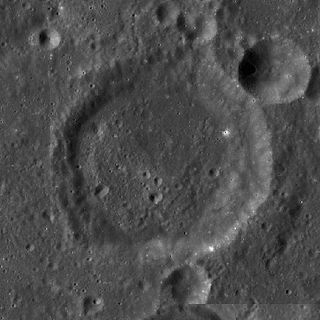
Almanon is a lunar impact crater that lies in the rugged highlands in the south-central region of the Moon. It was named after Abbasid Caliph and astronomer Al-Ma'mun. It is located to the south-southeast of Abulfeda, and to the north-northeast of the smaller crater Geber. The crater chain designated Catena Abulfeda forms a line between the south rim of Abulfeda and the north rim of Almanon, continuing for a length of about 210 kilometers to the Rupes Altai scarp.

Democritus is a lunar impact crater that is located on the northern part of the Moon, just to the north of the Mare Frigoris. Just to the south of Democritus is the lava-flooded crater Gärtner, which forms a bay on the mare. Directly to the north is Arnold, another flooded formation.

Blanchinus is a lunar impact crater in the rugged south-central highlands of the Moon. It is named after Italian astronomer Giovanni Bianchini whose Latinized name is Blanchinus. Adjacent to its south is the crater Werner, and La Caille is attached to the northwest rim. To its west is the prominent formation Purbach.

Bečvář is a lunar impact crater that is located near the equator on the far side of the Moon. It lies to the northeast of the crater Necho, within that feature's ray system. To the north-northeast is the crater Gregory.

De Roy is a lunar impact crater that is located on the far side of the Moon, just behind the southwestern limb. This portion of the lunar surface is brought into view during favorable librations, allowing observation of this formation. However the crater is viewed from the side when watched from the Earth, and little detail can be seen. De Roy lies to the west of the crater Arrhenius, and east of the larger Boltzmann.

Davisson is a lunar impact crater that is located on the far side of the Moon from the Earth. This crater lies across the eastern rim of the huge walled plain Leibnitz, and the rim and outer rampart intrudes into the interior floor of Leibnitz. To the east-northeast of Davisson is the walled plain Oppenheimer, a formation only somewhat smaller than Leibnitz.

Foucault is a small lunar impact crater that lies along the southern edge of Mare Frigoris, to the southeast of the crater Harpalus. In the rugged terrain to the south of Foucault is Sharp. The outer perimeter of Foucault forms a somewhat irregular circle, with slight outward bulges to the south and northeast. The inner wall of the rim is not notably terraced, and slopes down directly to the uneven floor. It is named after physicist Léon Foucault, most famous for the Foucault pendulum.

Eichstadt is a lunar impact crater that is located in the eastern section of the Montes Cordillera range that encircles the Mare Orientale impact basin. It lies toward the southwestern limb of the Moon, and so appears oblong when viewed from the Earth due to foreshortening. Over 200 kilometers to the east of Eichstadt are the craters Darwin and Lamarck, and to the south is Krasnov.
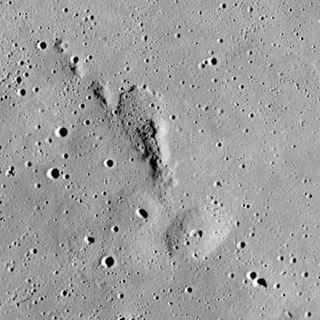
Mons Esam is a small, isolated mountain in the northern part of the Mare Tranquillitatis. It is located to the southeast of the crater Vitruvius and to the west-northwest of Lyell. To the northeast of this ridge is the bay called Sinus Amoris.

Danjon is a lunar impact crater on the far side of the Moon. It lies less than a crater diameter to the east-southeast of the larger crater Langemak. To the east-northeast of Danjon is the crater Perepelkin, and due south lies the walled plain Fermi.
References
- ↑ Holthuijsen, Leo H. (2007). Waves in oceanic and coastal waters. Cambridge: Cambridge University Press. p. 106. ISBN 978-0-521-86028-4.
- ↑ "Mars Nomenclature: Crater, craters". Gazetteer of Planetary Nomenclature. USGS: Astrogeology Research Program. Retrieved 16 August 2007.
- ↑ Morton, Oliver (2002). Mapping Mars: Science, Imagination, and the Birth of a World . New York: Picador USA. pp. 22–23. ISBN 0-312-24551-3.
- ↑ Cocks, E. E. & Cocks, J. C. (1995). Who's Who on the Moon: A Biographical Dictionary of Lunar Nomenclature. Tudor Publishers. ISBN 0-936389-27-3.
- ↑ Weisstein, Eric W. "Airy Projection." From MathWorld--A Wolfram Web Resource. http://mathworld.wolfram.com/AiryProjection.html
- ↑ The Airy Transit Circle
- ↑ The Airy Transit Circle, By Emily Winterburn, BBC. Last updated 2011-02-17